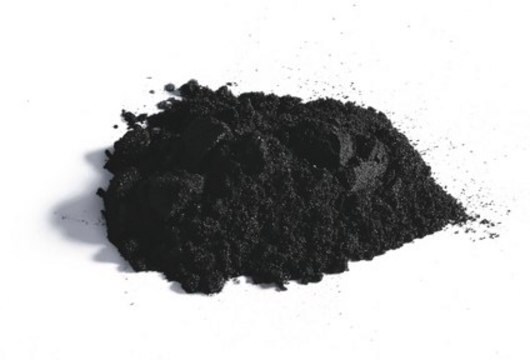Key Documents
05105
Activated charcoal
powder
Synonim(y):
Charcoal activated
About This Item
Polecane produkty
ciśnienie pary
<0.1 mmHg ( 20 °C)
Poziom jakości
opis
iodine-adsorption (0.05 mol I2/I) > 70 mL/g
methylene blue-adsorption > 12 mL/0.1 g 0.15% sol.
Postać
powder
temp. samozapłonu
842 °F
rezystywność
1375 μΩ-cm, 20°C (graphite)
metody
photometry: suitable
pozostałość po prażeniu
≤2%
mp
3550 °C (lit.)
ślady anionów
chloride (Cl-): ≤5000 mg/kg
sulfate (SO42-): ≤5000 mg/kg
ślady kationów
Ca: ≤1000 mg/kg
Cd: ≤10 mg/kg
Co: ≤10 mg/kg
Cr: ≤10 mg/kg
Cu: ≤10 mg/kg
Fe: ≤300 mg/kg
K: ≤200 mg/kg
Mg: ≤200 mg/kg
Mn: ≤50 mg/kg
Na: ≤500 mg/kg
Ni: ≤10 mg/kg
Pb: ≤10 mg/kg
Zn: ≤10 mg/kg
Zastosowanie
food and beverages
general analytical
ciąg SMILES
[C]
InChI
1S/C
Klucz InChI
OKTJSMMVPCPJKN-UHFFFAOYSA-N
Szukasz podobnych produktów? Odwiedź Przewodnik dotyczący porównywania produktów
Opis ogólny
- Fiber coating to compare solid-phase microextraction efficiency of the multiwalled carbon nanotubes in water and milk samples before GC-ECD analysis.
- It may be used to study its effect on tissue cultures of Daucus carota, Happlopapus gracilis and Allum cepa var. proliferum, to check the adsorption of metabolites inhibiting morphognesis.
- It may also be used in the plant tissue culture to increase the adsorption of auxin and cytokinin from the culture media.
- It may also be used as the primary gastrointestinal decontamination procedure after acute drug overdose.
- It may also be used for the adsorption of dyes namely malachite green, bromophenol blue, alizarine red-S, methylene blue, eriochrome black-T, phenol red, methyl blue, and methyl violet from aqueous media.
- Oral activated charcoal may be also used for adsorption of theophylline, hence can be effectively used in patients with theophylline poisoning.
Kod klasy składowania
11 - Combustible Solids
Klasa zagrożenia wodnego (WGK)
WGK 3
Temperatura zapłonu (°F)
Not applicable
Temperatura zapłonu (°C)
Not applicable
Środki ochrony indywidualnej
Eyeshields, Gloves, type N95 (US)
Wybierz jedną z najnowszych wersji:
Masz już ten produkt?
Dokumenty związane z niedawno zakupionymi produktami zostały zamieszczone w Bibliotece dokumentów.
Klienci oglądali również te produkty
Nasz zespół naukowców ma doświadczenie we wszystkich obszarach badań, w tym w naukach przyrodniczych, materiałoznawstwie, syntezie chemicznej, chromatografii, analityce i wielu innych dziedzinach.
Skontaktuj się z zespołem ds. pomocy technicznej





